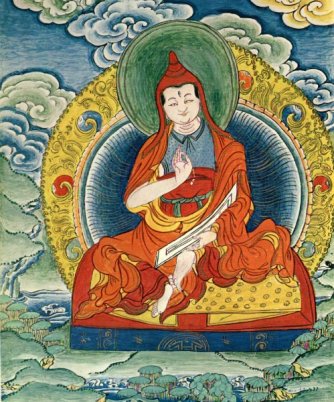Vairotsana on:
[Wikipedia]
[Google]
[Amazon]
 Vairotsana () was a
Vairotsana () was a
Excerpt Chapter
/ref>
(accessed: September 14, 2008)
Print
* The Nyingma School of Tibetan Buddhism; HH Dudjom Rinpoche, ed. and trans. by Gyurme Dorje and Matthew Kapstein; Wisdom Publications, 1991 * {{Authority control Scholars of Buddhism from Tibet Dzogchen lamas Nyingma lamas Translators to Tibetan Translators from Sanskrit 8th-century translators
 Vairotsana () was a
Vairotsana () was a lotsawa
Lotsawa () is a Tibetan word used as a title to refer to the native Tibetan translators, such as Vairotsana, Rinchen Zangpo, Marpa Lotsawa, Tropu Lotsawa Jampa Pel and others, who worked alongside Indian scholars or panditas to translate Buddhi ...
or "translator" living during the reign of King Trisong Detsen, who ruled 755-97 CE. Vairotsana, one of the 25 main disciples of Padmasambhava, was recognized by the latter as a reincarnation of an Indian pandita. He was among the first seven monks ordained by Śāntarakṣita
(Sanskrit; , 725–788),stanford.eduŚāntarakṣita (Stanford Encyclopedia of Philosophy)/ref> whose name translates into English as "protected by the One who is at peace" was an important and influential Indian Buddhist philosopher, particul ...
, and was sent to Dhahena in India to study with Śrī Siṅgha, who taught him in complete secrecy. Śrī Siṅgha in turn entrusted Vairotsana with the task of propagating the semde and longdé sections of Dzogchen in Tibet
Tibet (; ''Böd''; ) is a region in East Asia, covering much of the Tibetan Plateau and spanning about . It is the traditional homeland of the Tibetan people. Also resident on the plateau are some other ethnic groups such as Monpa people, ...
. He is one of the three main masters to bring the Dzogchen teachings to Tibet, the two others being Padmasambhava and Vimalamitra, and was also a significant lineage holder of trul khor.
Shechen Gyaltsab mentions in his ''Pond of White Lotus Flowers'' that before meeting Śrī Siṅgha, Vairotsana had met the wisdom forms of the two vidyadhara
Vidyadhara(s) (Sanskrit , literally "wisdom-holders") are a group of supernatural beings in Indian religions who possess magical powers. In Hinduism, they also attend Shiva, who lives in the Himalayas. They are considered ''Upadeva''s, or demi ...
s Garab Dorje and Mañjuśrīmitra Mañjuśrīmitra (d. 740 CE) () was an Indian Buddhist scholar. He became the main student of Garab Dorje and a teacher of Dzogchen.
Nomenclature and etymology
Mañjuśrī-mitra was his ordination-name—before ordination he was named "Siddhi-garbh ...
in a miraculous pagoda at Dhahena. After he had presented a huge offering of gold, they conferred empowerment upon him and bestowed their blessings, with the prediction that he would receive the complete teachings from Shri Singha.
He is named after Vairocana, the central dhyani Buddha.
Disciples
Vairotsana's chief disciples wereYudra Nyingpo
Yudra Nyingpo () was one of the chief disciples of Vairotsana and one of the principal lotsawa "translators" of the first translation stage of texts into Tibetan.
Yudra Nyingpo became one of the greatest masters of Nyingma Dzogchen
Dzogch ...
, Sangtön Yeshe Lama, Pang Gen Sangye Gönpo, Jnana Kumara of Nyag (Wylie: ''nyag ye she gzhon nu''), and Lady Yeshe Drönma (Wylie: ''jo mo ye shes sgron''). An especially renowned disciple was the old Pang Gen Mipham Gönpo whose disciples attained the rainbow body for seven generations by means of the oral instructions of Longdé entitled 'Dorje Zampa' (Wylie: ''rdo rje zam pa'') also known as the 'Vajra Bridge'. Tsele Natsok Rangdröl, Terdag Lingpa Gyurmey Dorje, and Jamgon Kongtrul are regarded as reincarnations of Vairotsana.
Translations
Travels
Born in Pagor, Vairotsana was sent to India by Trisong Detsen to learn theDharma
Dharma (; sa, धर्म, dharma, ; pi, dhamma, italic=yes) is a key concept with multiple meanings in Indian religions, such as Hinduism, Buddhism, Jainism, Sikhism and others. Although there is no direct single-word translation for '' ...
with Indian panditas. Vairotsana also travelled widely in China, Khotan, Nepal
Nepal (; ne, नेपाल ), formerly the Federal Democratic Republic of Nepal ( ne,
सङ्घीय लोकतान्त्रिक गणतन्त्र नेपाल ), is a landlocked country in South Asia. It is ma ...
, Zhangzhung, amongst other places. In China, Vairotsana received teachings from nineteen teachers. Amongst these were: Kusula Bhitigarbha, Dharmabodhi, Vajra Sukha Deva, Pandita Barma, Tsenda Ritropa, Mahabodhi, Shri Ani, Moheyan, Surya Ghirti and Satipa.Zenkar, Ala (1998). "Introduction: A Summary of the Text" in: Palmo, Ani Jima (Eugenie de Jong; translator); Nyingpo, Yudra (compilor, ''et al.'') (2004). ''The Great Image: the Life Story of Vairochana the translator.'' Shambala Publications, Inc.: Boston, Massachusetts, U.S.A. (pbk.: alk. paper). p.xxviiiExcerpt Chapter
/ref>
Publications
* Eye of the Storm: Vairotsana's Five Original Transmissions (Snga 'gyur lnga)—translation and commentary by Keith Dowman; Vajra Publications, Nepal.Notes
References
Electronic
* * Schaeffer, Kurtis R. (2000). "The Religious Career of Vairocanavajra - a Twelfth-Century Indian Buddhist Master from Dakṣiṇa Kośala" in ''Journal of Indian Philosophy''; vol. 28: pp. 361–384. Netherlands: Kluwer Academic Publishers. Source(accessed: September 14, 2008)